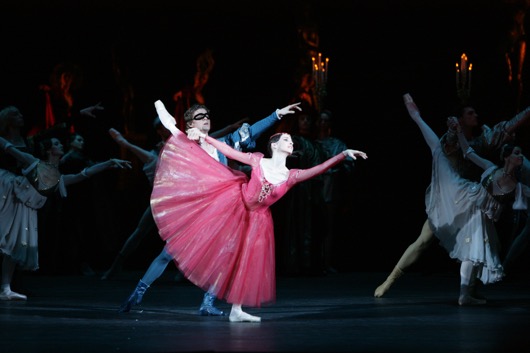
Today we have something special for you – the Bolshoi Ballet’s Anna Nikulina talks about what it’s like to dance the role of Juliet…
What are the challenges in preparing for the role of Juliet?
For me most likely the biggest challenge in preparing for Juliet was that the actual ballet goes by too quickly. The performance is only two hours and it is hard to live through this role for such a short period of time, beginning with Juliet as a young girl, only 14 years old and to go through such a difficult journey in love, suffering, and death. And because there are so many different sides and emotions and to have to release all this in one performance was probably the most difficult thing.
What do you enjoy most about dancing this role, and how is it different than other lead roles?
I would say that Juliet is a true role, because in performances there are “parts” and there are “roles.” And I think I enjoy the difficulty in it both physically and emotionally. Juliet is a young girl and then falls in love with Romeo and there are difficult aspects of this role physically, but in reality it is not the most difficult in terms of technique; there are certainly harder roles. But to live through it is hard – you can keep rehearsing this again and again, and with each rehearsal, you discover new things and new sides of Juliet that you can reveal. This is what I enjoy most.
There needs to be a special bond with your partner (Romeo) for this ballet. Is it difficult to create this? Do you do anything specific to make it happen?
Regardless, I try to live through the performance with Romeo and soon you get this feeling, slowly, not right away that occurs between two people, and I remember that once Yuri Nikolaevich Grigorovich said to me during rehearsal that he saw a certain chemistry between us. And I truly started to fall in love during this time, in love with Sascha Volchkov as Romeo. And I felt really as though I loved him. But this was of course during rehearsals (laughs). And I think Sascha had a similar experience. We had a special and unique connection and I actually would not have preferred to dance this ballet with anyone else at the time.
Can you explain the role of the music in this ballet? Do you have any favorite sections?
The role of the music is truly enormous and it is genius. And you can live through all your emotions through this music. My favorite part is probably the balcony scene and the end of Act II, because it is so tragic and when you listen to the music without dancing it is amazing itself but when you are able to move and emote to it, it is truly amazing.
This is an extremely emotional ballet. What specific things do you use to communicate your emotions to the audience clearly?
Your coach is very helpful in this process because when you are rehearsing, you are expressing emotions and it is important for these emotions to be visible, so your coach can really help to determine whether you are delivering those emotions enough to reach the audience. There are times when you think you are expressing everything you can, even through movement, but you realize that what you are trying to express isn’t always clear. To express emotions, the coach’s eye is very important. Also, Zeffirelli’s film really helped me and inspired me in my interpretation of Juliet.
Viewers across the US have the opportunity to see Anna Nikulina perform Juliet at the cinema – the Bolshoi Ballet will be on the big screen for one performance only on March 8th! Search here for a theater near you.
BIO: Anna Nikulina was born in Moscow. In 2002, she completed her training at the Moscow State Academy of Choreography (teacher Elena Vatulya) with distinction and joined the Bolshoi Ballet Company. She rehearsed under the late Yekaterina Maximova. In 2004, at the age of 19, she danced Odette-Odile for the first time. Today her teacher-repetiteur is Nina Semizorova.
She took part in the Bolshoi Theatre Studio of New Choreography project, dancing Aurora in Riccardo Drigo’s Rosary pas de quatre from the ballet The Awakening of Flora (choreography Marius Petipa, reconstruction Yuri Burlaka) and the Carpets pas de quatre from Cesar Pugni’s ballet The Humpbacked Horse (choreography Alexander Gorsky, reconstruction Yuri Burlaka; 2004), and likewise — with Denis Savin — she appeared in the number Acquisition to music by Sergei Rachmaninov, produced by Yuri Klevtsov (2006)
In 2007, she appeared in the ballet Old Ladies Falling Out to music by Leonid Desyatnikov (choreography by Alexei Ratmansky), which was shown first at the Territory Festival, and then under the auspices of the Studio of New Choreography project (workshop).
Disclosure: 4dancers accepts compensation for promoting this series




